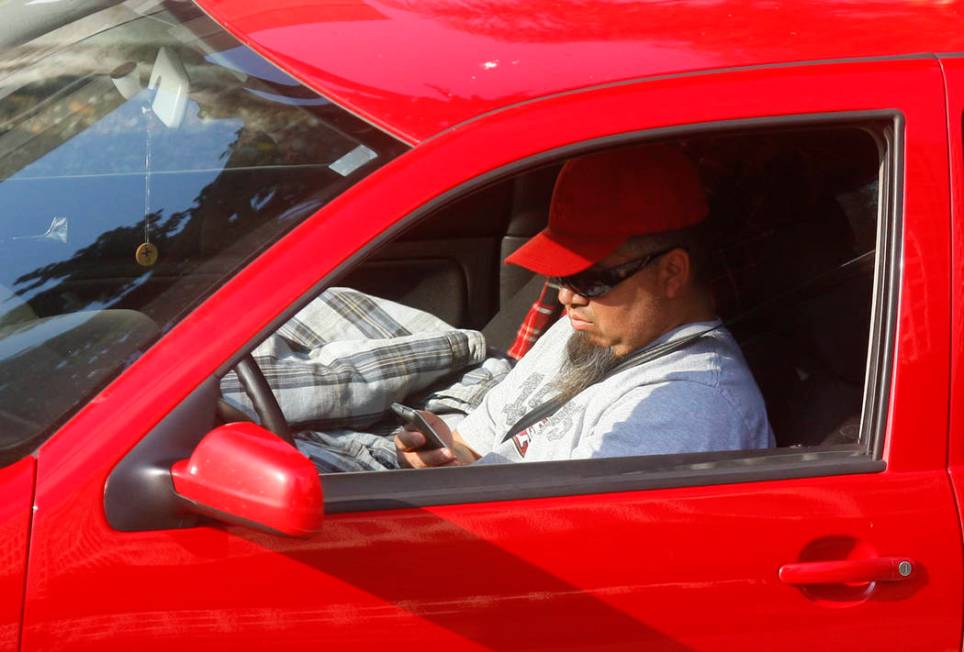Las Vegas drivers need to put smartphones down, experts say

As smartphones become an essential part of most people’s lives, the devices are causing motorists to make some not-so-smart decisions behind the wheel, experts say.
People are finding it tough to put down their phones at any time during the day, including while behind the wheel.
Although it’s not as easy to track distracted driving crashes, especially fatal occurrences, as the driver has to admit to using a smart device while driving, safety officials insist it is a concern and urge valley drivers to put the phone down and pay attention to the road.
“Out of all the data we have, distracted driving data is the one that’s lacking,” said Andrew Bennett, Department of Public Safety spokesperson.
In 2017 there were 311 fatalities on Nevada roadways, with 15 of those attributed to distracted driving, Bennett said.
“When you hear that, you might think that’s a low number, but all 15 of those are 100 percent preventable,” he said. “Each one of those 15 lives could have been saved by someone simply putting their phone down at the time they were driving.”
Surprisingly, the most common demographic to use their phones while driving are adults, not teens, which is likely due to them being used to using their phones while driving before the practice was banned.
“At one point it was legal to use your phone while driving,” Bennett said. “The older demographic had to change their behavior after being told they can’t do that now. Whereas with the teens, it’s always been illegal to text while driving. If a teenager gets their license tomorrow, there’s never going to be a time in their life where it’s legal to use a phone while driving.”
Smartphone app makers utilize a “variable ratio method” to induce people to look at their devices, said James J. Durbin, an addiction psychologist at Pathways Therapy and Wellness Center.
The method, which is similar to that used for slot machines, provides reinforcement on an unpredictable basis, he said.
“The reinforcement schedule creates a high steady rate of responding,” Durbin said. “Gambling is a good example of the variable ratio schedule.”
Critical aspects that get users hooked to their electronic device include playing smartphone games that offer rewards to players who reach certain milestones, the act of swiping on an app and the fear that people could be missing out on something, which will encourage them to check their phone more often.
Another factor is push notifications that many apps and messaging services incorporate in their programs.
“Getting that notification, whether it’s on the screen or a sound, will release some dopamine into the brain,” Durbin said. “It makes you feel good. It’s another way these smartphone and apps get you hooked.”
The Center for Internet and Technology Addiction has an online screening test that can determine whether a person might have an unhealthy relationship with their smartphone.
“It can help you be aware if your phone is problematic for you,” Durbin said. “Then you can set some boundaries and limits to your use, which rolls into impulse control.”
To help curb phone use while driving, Durbin offered some tips that are good advice for those who rarely check their phone as well as those who can’t put their device down: Put your electronic device in the back seat, where it can stay out of your reach. Put your smartphone in a backpack or purse. Put your smartphone in do-not-disturb mode.
Lock your phone in your trunk, to curb those who know they’ll likely check it, no matter where the phone is in the car.
Motorists can also opt to use wireless connection to answer phone calls and text via their voice.
Although that is a much safer route than handling a smartphone while driving, Bennett said he’d discourage the use, as it still causes some level of distraction.
“Put the phone down. When you’re traveling from point A to point B that’s the most important thing you’re going to do all day and anything else can wait,” he said. “If a call or a text is that important, pull off the road at the next exit, pull into a parking lot, just don’t drive.”
I-15 closure canceled
Next week’s planned closure of Interstate 15 between Flamingo and Spring Mountain roads has been canceled, the Nevada Department of Transportation announced Friday.
The closure was scheduled to install Active Traffic Management signs as part of Project Neon, a nearly $1 billion four-mile-long widening of I-15 from the U.S. Highway 95 interchange to Sahara Avenue that began in 2016.
A total of 42 ATM signs are scheduled to go up along I-15 as part of Project Neon.
A new overnight closure date to carry out the work will be set later.
Questions and comments should be sent to roadwarrior@reviewjournal.com. Please include your phone number. Follow @RJroadwarrior on Twitter.